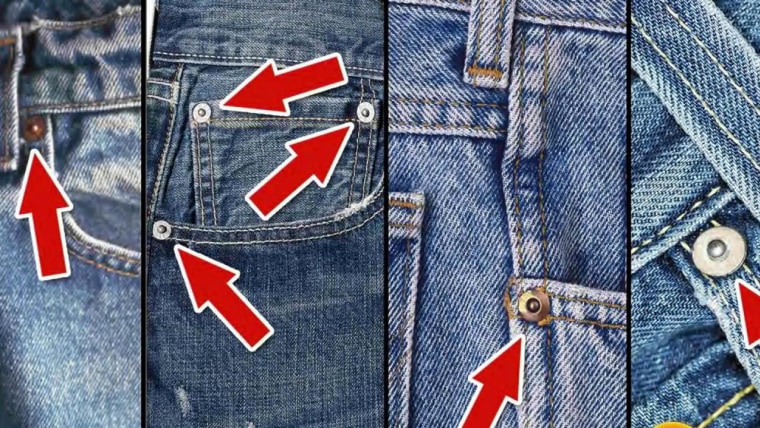Pocket Guide To Writing In History
If you grew up in the age of Levi's, you have always known the luxury of a pocket to guard your phone, stash your lipstick or plunge your hands into when an awkward moment arises.
Pockets are the heroes of convenience and multitasking — in fact, they've even inspired a song or two. In 1995, Alanis Morisette recounted having "one hand in her pocket" while giving a high-five, flicking a cigarette, flashing a peace sign, playing the piano and hailing a taxi cab.

However, things weren't always so "fine, fine, fine." Pockets have seen many makeovers over the years, and their standard presence on both men's and women's clothing is relatively recent. In fact, their history is rife with class and gender politics.
Ready to dig into the history of pockets? They're deeper than you may think.
Pockets first began appearing on waistcoats and trousers about 500 years ago. As you probably already know, about half the population wasn't wearing trousers back then. For women in the 1600s and beyond, pockets were a separate garment that tied on between a skirt and petticoat. They were able to be removed and worn with multiple outfits.
RELATED: It's not you — women's clothing sizes don't make sense
These pockets functioned like purses and could hold enough treasures to make Mary Poppins (and her infinitely expanding carpet bag) jealous. Pincushions, thimbles, pencil cases, knives, scissors, keys, spectacles, watches, diaries, personal-grooming objects like combs and mirrors, and (obviously) snacks were just some of the items commonly toted around below the belt, according to an exhibit about pockets at the Victoria and Albert Museum in London.
It's good to be prepared for every situation, you know? (Some things never change.)
While pockets occasionally appeared as details on "country-style" dresses or aprons, they were more often layered underneath — a concept made possible by the full skirts and forgiving silhouettes of the era. Skirts were often made with built-in slits for easy access and working women who carried money often preferred to keep them hidden for safety reasons, reported a history of tie-on pockets by historians Barbara Benbo and Seth Denbo.
Related: Not all button-up shirts are button-downs. Here's why.
That all changed in the late 1800s, when the Victorian era saw trends shift toward slim skirts and tiny waists. Pockets became smaller and more ornate — and basically useless.
These "reticules" — really early handbags — were worn outside the clothes and meant to be pinned on or attached to a belt. Their very daintiness was a status symbol in itself, signaling a life of leisure and a husband who handled the finances.
From there, purses took off. Pockets as we know them more or less disappeared from women's clothing, though they continued to be a fixture on men's tailoring.
That is, until the 1920s, when women co-opted menswear styles for themselves — and therein took back the pocket! What a time to be alive.
(The right to vote was exciting, too. But come on, guys, the pocket.)
Boyish cuts and menswear-inspired looks gained popularity in the late '20s, especially with Hollywood stars like Greta Garbo and Marlene Dietrich. But the trend remained somewhat controversial and off-the-radar until 1933, when Women's Wear Daily became the first big name to address the trend in an article called "Will Women Wear Trousers?"
At the time, WWD simply reported the trend without getting too deep into what it represented. But in a 100th anniversary issue in 2010, WWD called the story one of the biggest moments in fashion: the "first major moment in the limelight" for "gender-bending, borrowed-from-the-boys style."
"While Women's Wear Daily has been reporting the acceptance of trousers in cinema circles," read the 1933 article, "and while the consumer press has been discussing the controversial subject 'Will women wear trousers?' at least two progressive manufacturers … alert to the ever-shifting whims of fashion, have been quietly at work designing tailored cloths to meet this demand."
The takeaway being that the consumer dictates the market, to an extent. So the menswear trend was something women wanted and embraced despite the controversy — not something the patriarchy forced upon them. Aka a total feminist win.
Once androgynous fashions became more common, so did pockets — though the rise of purses allowed them to be geared more toward form than function. The mid-1900s saw lots of shallow but dapper-looking pockets that couldn't hold a compact, much less an iPhone.
Luckily, that wasn't an issue at the time.
Related: Jimmy Fallon's 'The Pocket Dial" reinvents the pocket square
And then jeans came along, and the world got better in so many ways. But most crucially to this conversation, people realized that having actual, durable pockets on their day-do-day clothing was kind of the best.
And now all we have to worry about is remembering to take our phones out of them before we go to sit down. And, maybe, how to get that Alanis Morissette song out of our heads.
Pocket Guide To Writing In History
Source: https://www.today.com/style/surprisingly-deep-history-pockets-you-never-knew-t101940
Posted by: southwoodperaweltake.blogspot.com

0 Response to "Pocket Guide To Writing In History"
Post a Comment